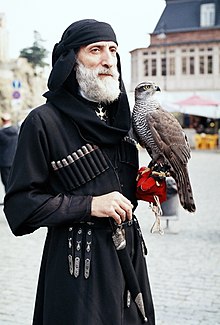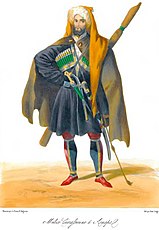This is an old revision of this page, as edited by Normiehater (talk | contribs) at 12:42, 30 April 2021 (edited photos). The present address (URL) is a permanent link to this revision, which may differ significantly from the current revision.
Revision as of 12:42, 30 April 2021 by Normiehater (talk | contribs) (edited photos)(diff) ← Previous revision | Latest revision (diff) | Newer revision → (diff) High-necked wool coat worn by men in the Caucasus
A chokha also known as the cherkeska is a woolen coat with a high neck that is part of the traditional male dress of peoples of the Caucasus.
History and revival
According to Alexander Saveliev, Candidate of Historical Sciences, the prototype of chokha dates back to a thousand years and may have been a Khazars caftan, from which it was borrowed by other the other inhabitants the Caucasus. The chokha was in wide use among inhabitants of Caucasus from the 9th century until the early 20th century, when it declined during the Soviet Era.. Nowadays, chokha is no longer in use but continues to still be worn for ceremonial and festive occasions. In Georgia it is used as a symbol of national pride, and is frequently worn by Georgian men at weddings and official functions.
Types

Aside from the general Caucasian chokha which is worn by many ethnicities in the Caucasus and also by the Kuban Cossacks, there are four types of chokhas that are used primarily among Georgians: the Kartl-Kakheti chokha (Kartli and Kakheti are eastern Georgian provinces), the Khevsur chokha (mainly in the Mtskheta-Mtianeti province of Georgia), the Adjarian chokha (mainly found in western Georgian provinces such as Adjara and Guria, previously also in Lazona), and the general Caucasian chokha.
The word chokha in Persian means 'outfit made of fabric'. Russians and Ukrainians called it a cherkeska (meaning 'of/from Circassia'), and the Kuban Cossacks adopted it as part of their costume. In Circassian languages, the chokha is known as shwakh-tsia which means 'covers the horseman', or simply tsia, meaning 'from fabric', and fasha, which means 'fits you'.
In Georgia, special decorations, in addition to the chokha, were adopted by the Order of Chokhosani, who represented an elite cadre of generals, war heroes and famous poets.
The chokha is sewn from thick fabric and flares out at the bottom. In some parts of the Caucasus there are also female chokhas.
In the late 19th century and early 20th century there were three types of chokhas: the Khevsur chokha, the Kartl-Kakheti chokha and general Caucasian chokha.
General Caucasian chokha


This is the most widely used type of chokha in Caucasus, it has black leather belts decorated with silver pieces. It is usually a longer version of the Kartl-kakheti Chokha. The general Caucasian chokha is usually made of black, grey, white, blue, red or brown fabric. Traditionally a person's age determines the colour of their chokha. Generally, the chokha outfit includes a khanjali dagger, a beshmet worn under the chokha, gazyrs (bullet/charge holders), and a bashlyk (a hood, separate from the robe) or a papakha (a tall fur hat).
-
 Azeri from Karabakh. (artist - Gagarin GG)
Azeri from Karabakh. (artist - Gagarin GG)
-
 Circassian from Anapa. (artist - Gagarin GG)
Circassian from Anapa. (artist - Gagarin GG)
-
 Natukhay. (artist - Gagarin GG)
Natukhay. (artist - Gagarin GG)
-
 Kabardian. (artist - Gagarin GG)
Kabardian. (artist - Gagarin GG)
Kartli-Kakheti chokha

The Kartli-Kakheti version shares similarities with the general Caucasian chokha. In most cases, different decorations fill the bullet spaces. The Kartli-Kakheti chokha is longer than the Khevsur chokha and has triangle-like shapes on the chest, exposing the inner cloth called arkhalukhi. It tends to have gazyrs (locally called masri) on both sides of the chest-spaces. The skirt usually has slits on the sides. People wear them without belts. The Kartli-Kakheti chokha has long sleeves and is usually black, dark red or blue.
This is the most popular chokha used in Georgia, often seen in official meeting and musical performance.
Khevsurian chokha

The Khevsur chokha was worn in the Khevsureti province of Georgia in the Greater Caucasus mountains. The Khevsur chokha is considered to be the closest to the medieval version of the chokha. It is mostly short, with trapezoid shapes. The front side of the chokha has rich decorations and slits on the sides, which extend to the waist. The Khevsur chokha has rich decorations made up of crosses and icons.
| Ethnic groups in the Caucasus | ||||||||||||||||||
|---|---|---|---|---|---|---|---|---|---|---|---|---|---|---|---|---|---|---|
| Caucasian (areal) |
|  | ||||||||||||||||
| Indo- European |
| |||||||||||||||||
| Turkic |
| |||||||||||||||||
| Others | ||||||||||||||||||
References
- Азербайджанская национальная одежда [Azerbaijani national garments] (in Russian). Azclub.ru. Archived from the original on 2007-03-21. Retrieved 16 April 2013.
- "ЧЕРКЕ́СКА". Большая российская энциклопедия.
- McGuinness, Damien (10 July 2011). "Close-Up: Why Georgia's national costume is back in vogue". BBC.com. Retrieved 15 April 2018.
- "The history of the national costume. How did the Cossacks adopt the clothes of the Circassians?".
- Satenstein, Liana (May 5, 2017). "What Is Georgia's Traditional Chokha and Why Is It in Fashion?". Vogue.
- "Georgia: Love Your Country, Love Your Chokha". EurasiaNet.org. 2011-02-20. Retrieved 2013-04-16.
- Abashidze, Irakli. Ed. Georgian Encyclopedia. Vol. IX. Tbilisi, Georgia: 1985
- "БЕШМЕ́Т". Большая российская энциклопедия.
- In the original, the drawing is called "Bek-Tatar from Karabakh" ({ {lang-fr | Beck Tatare du Karabakhe}}). It is known that in the 19th century Russian travelers also called Azerbaijanis Tatars
- Georgian: ჩოხა chokha or ტალავარი t'alavari; Template:Lang-ab; Template:Lang-ady; Template:Lang-fa; Template:Lang-hy; Template:Lang-az; Template:Lang-ce; Template:Lang-kbd; Template:Lang-lez; Template:Lang-os; Template:Lang-ru; Template:Lang-uk